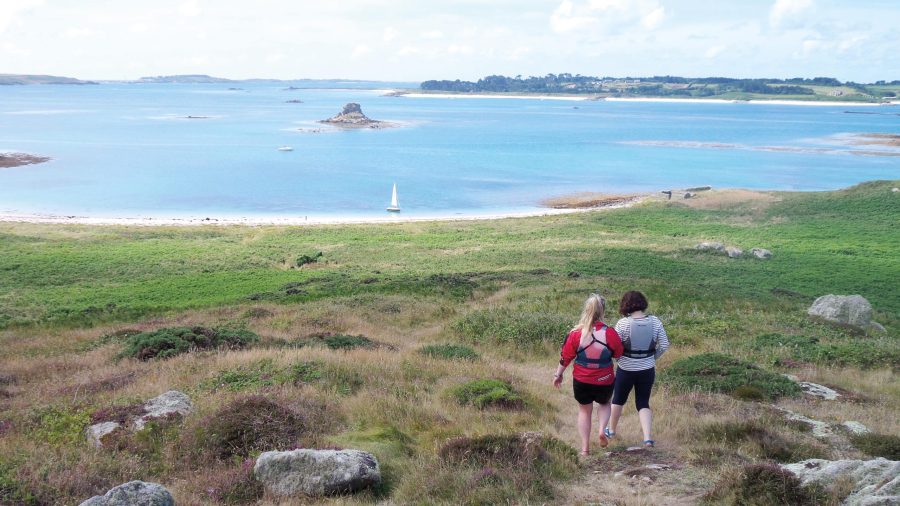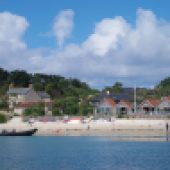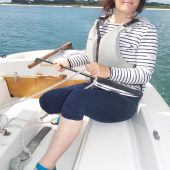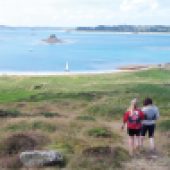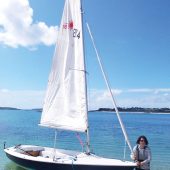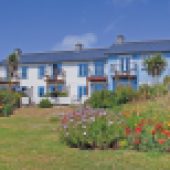Editor Alex Fisher sets sail around the shores of the Isles of Scilly. WORDS Alex Fisher PHOTOGRAPHS Jon Spong
Whether you love the romantic notion of island-hopping, Swallows and Amazons-style, or are inspired by the athletic skills of Olympic gold medallist Ben Ainslie, dinghy-sailing is a hugely appealing sport. Easy to pick up after a single session, children as young as five can enjoy the simple pleasures of pottering on the water, while older children and adults can hone their racing skills, making this an ideal holiday activity for all the family.
Dinghy-sailing first became a popular leisure activity around the end of the 19th century and was made an Olympic event in 1900. Originally, the boats would have been crafted from wood, but this changed to cheaper fibreglass in the 1970s. Due to their easy upkeep, most of the boats you’ll find in clubs and sailing schools will be made from fibreglass today.
With vast expanses of deserted sandy beaches, hidden coves and uninhabited islands the Isles of Scilly are the perfect place to learn to sail. Although the sea is often wild on the western shores, the waterways between the islands offer a protected and uncrowded haven for watersports. The Isles of Scilly Sailing Centre is based on the largest inhabited island, St Mary’s, but in July and August the centre also has a teaching base on sandy Ravensporth Beach on Tresco. It’s here that we are going to have our two-hour lesson.
10.30AM RIB RIDE
We’re picked up from the jetty on Bryher, the tiny island where we are staying, by Richard Mills who runs the Isles of Scilly Sailing Centre. The fastest way of getting to the Tresco base is around the island on his RIB. ‘Hold tight,’ he tells us, before heading out of the protected bay onto the ocean. Here the sea is rougher and we spot seals as we bounce over the waves. As soon as we enter the bay the sea instantly flattens and we glide into the little harbour. Then it’s shoes off and we jump into the water to wade to the shore.
11AM MEET THE TEACHER
Our instructor for the day is Anneliese. During term-time she studies medicine on the mainland, but this is her second season teaching sailing and she loves it. ‘I grew up in Cornwall and started sailing when I was five,’ she tells us. ‘I love being on the water and passing my skills onto other people. It’s a heavenly summer job.’ Her enthusiasm quickly rubs off on us. The clouds part and the sun sparkles on the crystal clear water and I can’t imagine being anywhere more beautiful. I roll up my trousers and follow her through the water onto the boat. My 11-year-old son follows, better dressed than me in his surf shorts. We clamber aboard the Laser 16 dinghy, which Anneliese tells us is very stable, and comfortable to sit in. It can seat up to six people, and Anneliese often takes out groups of children for ‘pirate’ trips, she tells us.
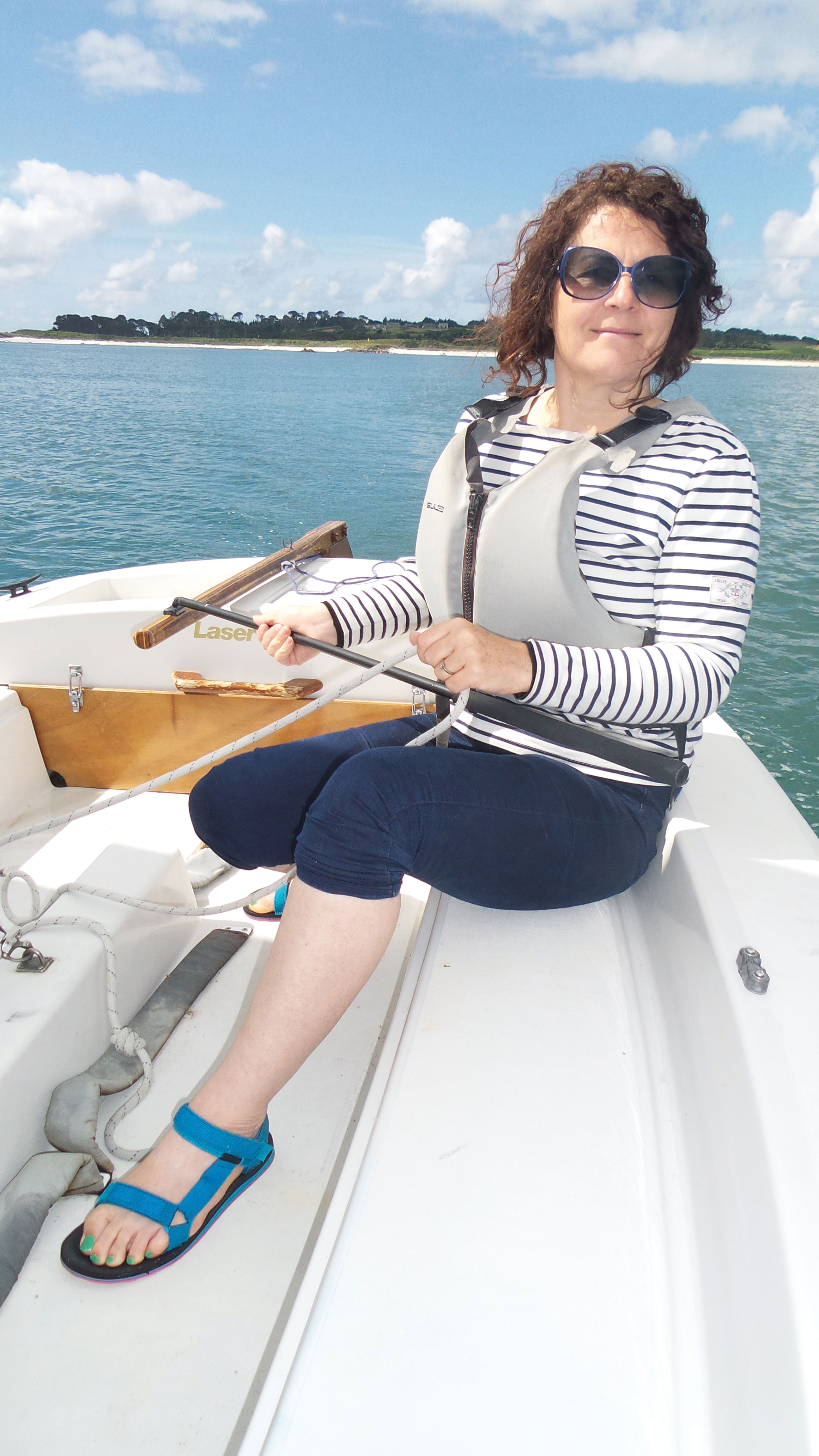
11.15AM SAFETY AT SEA
Before we head out to sea, Anneliese gives us a safety talk. We put on our life-jackets and are told how to use them. She talks us through the important aspects of the boat and highlights any hazards, in particular pointing at the boom – the beam that runs across the bottom of the sail. ‘You’ll remember it’s called the boom because that’s the sound it makes when it bangs your head,’ she says. My son laughs. ‘If I call “ready about” you need to duck beneath the boom and sit on the other side, OK?’ ‘OK.’ She shows us where the centreboard (or daggerboard) is – the fin that slides down into the water under the boat and stops it slipping sideways – and how to adjust its depth in the water. Then we make sure our weight is distributed evenly between the stern (rear) and bow (front) of the boat.
11.30AM SAIL AWAY
Anneliese guides us out onto the water, where there is just enough wind to fill the sail, and points out the rocks to avoid (Big Cheese and Little Cheese) before we have a go. She offers me the tiller. ‘If you want to go right, pull the tiller left; if you want to go left, push the tiller right,’ she explains. ‘Keep an eye on the sail. A flappy sail is an unhappy sail.’ She shows me how she holds a rope in one hand, which tightens or loosens the sail, while the other hand operates the tiller. The aim is to keep the boat into the wind enough to keep it moving, but not so much it flaps. I have a go, but it takes me a while to get the hang of coordinating my movements – moving one way to go another way – and the sail sags. But Anneliese is on hand to help me get to grips with it.
We’re heading to St Helen’s, an uninhabited island opposite Tresco, where, on longer sessions, they often land and build a fire, Robinson Crusoe-style. ‘The kids love it,’ says Anneliese. ‘They build shelters and cook sausages, it’s a real adventure.’
I pass the tiller to my son, and he picks up the steering faster than I did, as children often do. ‘Ready about!’ he shouts, and we duck beneath the boom and take our positions on the other side of the boat. The idea is to zigzag your way across the wind, towards your destination. With wind speed and wind direction changing all the time, this can be trickier than you might imagine. However, if you are not in any hurry, the experience of simply being on the water without the noise of an engine is sublime.
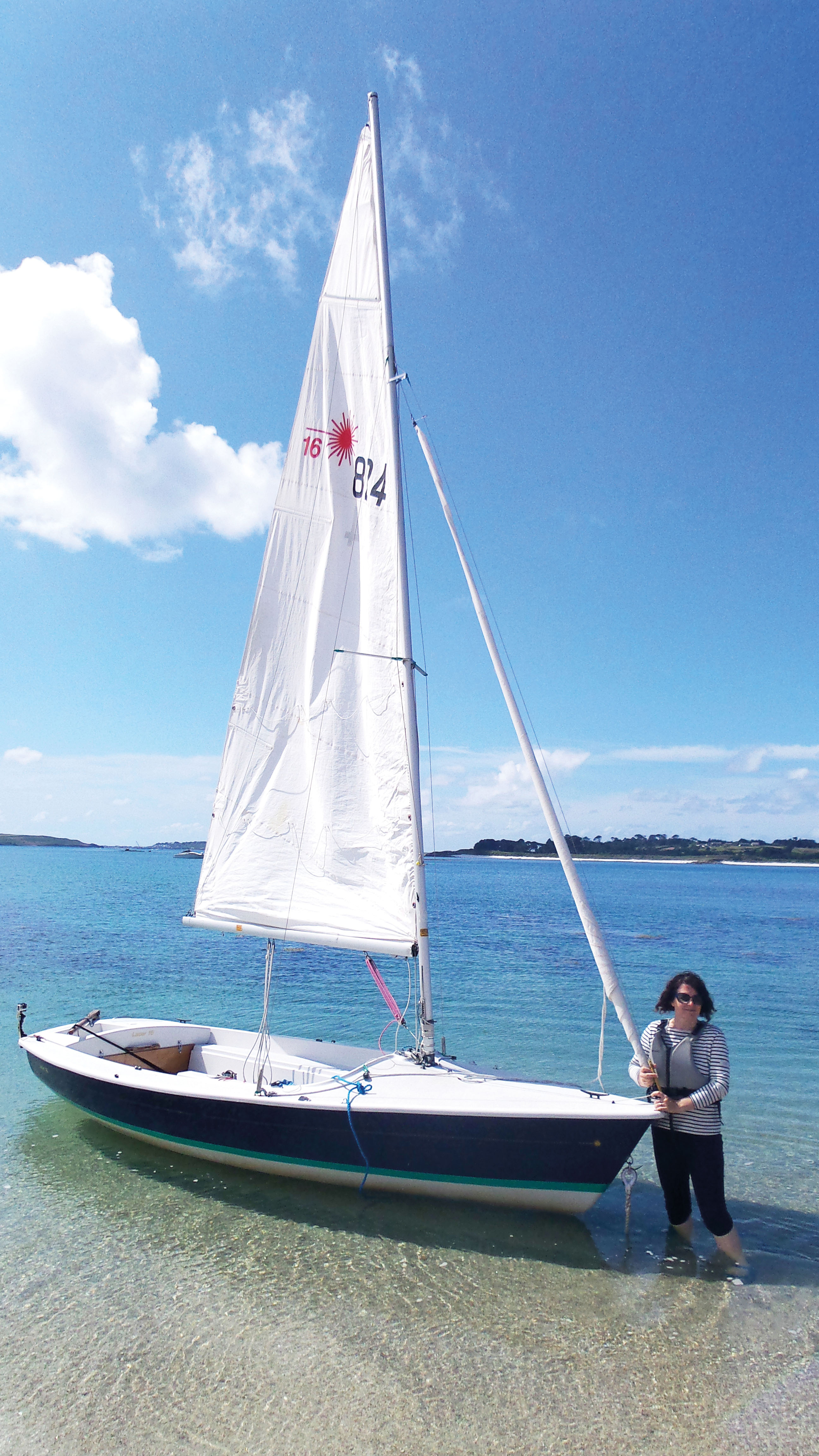
12PM SAINTLY STOPOVER
We anchor just off St Helen’s, jump off the boat and wade to the sandy shores. I recommend coming dressed to get soaked, or even to swim; it’s more fun. Although now uninhabited, there are remains of ancient settlements here, along with the ruins of an early Christian hermitage and the walls of the 18th-century Pest House, where sailors with contagious diseases were once quarantined. We walk to the highest point of this tiny island and are treated to an incredible 360-degree view of the archipelago. Our dinghy sits waiting for us below, bobbing gently in the bright blue sea.
12.30PM SAILORS RETURN
A little more confident with the tiller, the boom and the sail now, we head back to Tresco. The wind has picked up slightly and we practise tacking – zigzagging across the wind to make our way to the harbour. My coordination has now improved slightly, and I get a small taste of what it might be like to tune yourself in to the elements, feel the pull and push of the wind, read the direction of the waves, and make your way across the sea by your own efforts alone. It’s a wonderful thing.
ASK THE PRO
Richard Mills is owner and director of the Isles of Scilly Sailing Centre.
‘I first sailed as a young child when my family lived on St Mary’s. We left the Isles of Scilly when I was four, but I moved back aged 17 to work at the sailing centre I now run. Eventually I was able to buy the business. Dinghy-sailing offers a wonderful freedom. Once you’re out at sea all you hear is the wind and the water; there’s a euphoria of peace you feel when sailing. You get a real sense of achievement after each trip, as a certain amount of skill is needed to sail without an engine.’
NEED TO KNOW
HOW DO I BOOK?
The Sailing Centre can provide dinghy lessons to suit the participants, from beginners in small groups to one-to-one lessons and RYA courses. The main office is on St Mary’s, and the Tresco centre at Ravensporth is open during school holidays, and July and August. Prices start from £40 an hour for an instructor and a boat. For more details, visit sailingscilly.com, St Mary’s office 01720 422060, Tresco office 01720 424919.
HOW TO GET THERE
The SKYBUS flies from Exeter in Devon, and Newquay and Penzance in Cornwall. You can also take the Scillonian ferry, which sails from Penzance and takes around three hours. To book either option, go to islesofscilly-travel.co.uk or call 01736 334220.
WHERE TO STAY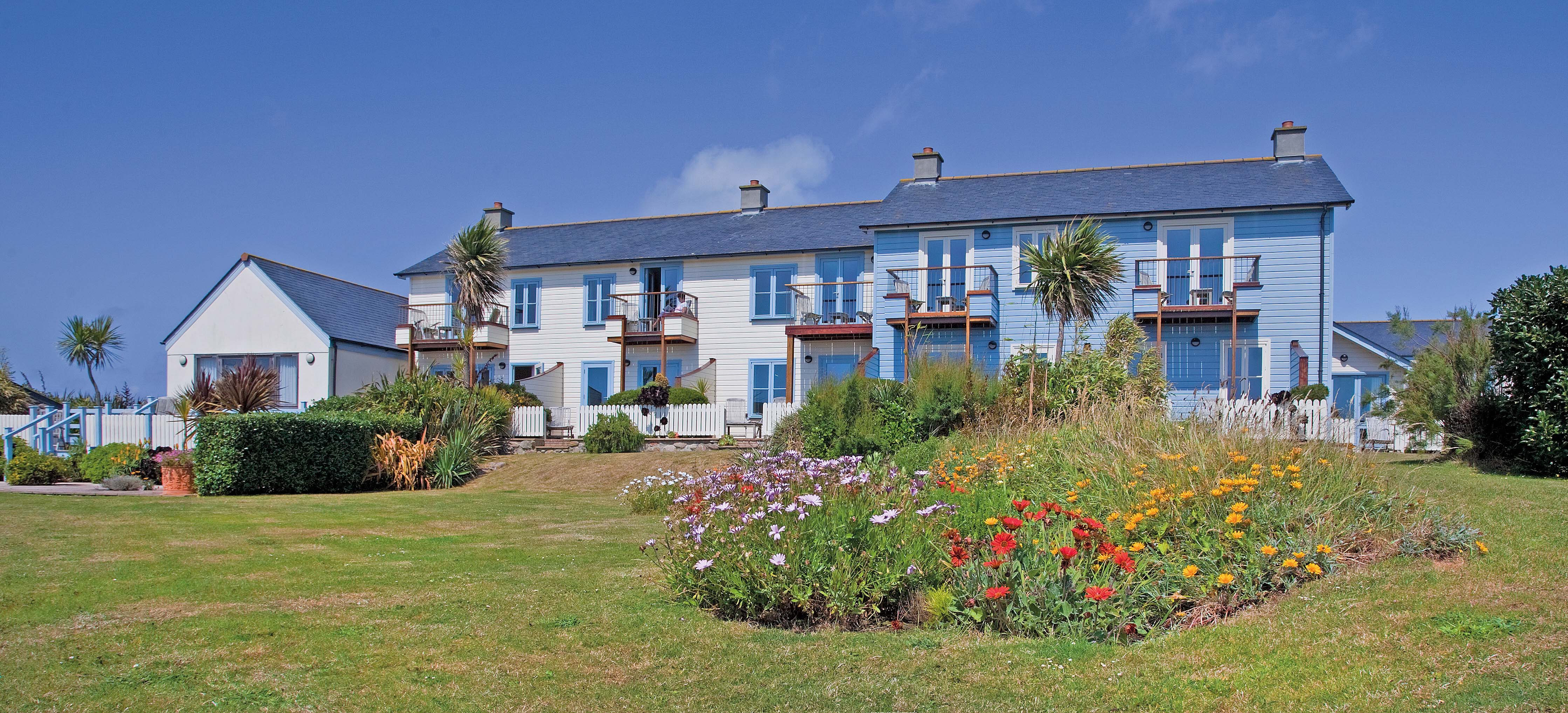
coast stayed at the Hell Bay Hotel on Bryher, which is the highest-rated hotel on the Isles of Scilly, with 25 suites in a stunning natural location. Prices start from £125 (01720 422947, hellbay.co.uk).
For more information on the islands, see visitislesofscilly.com.

